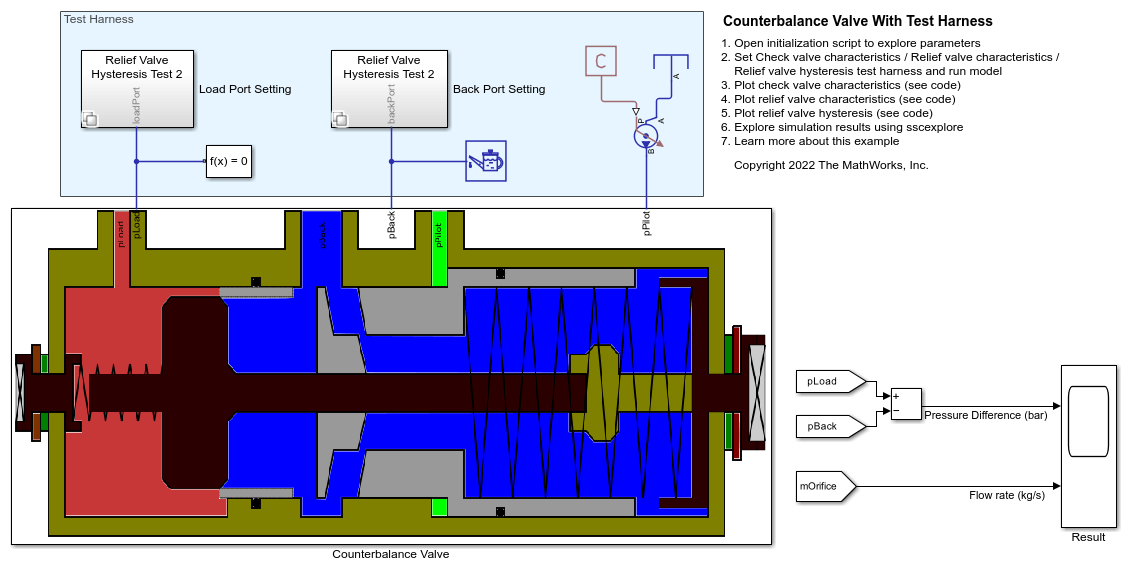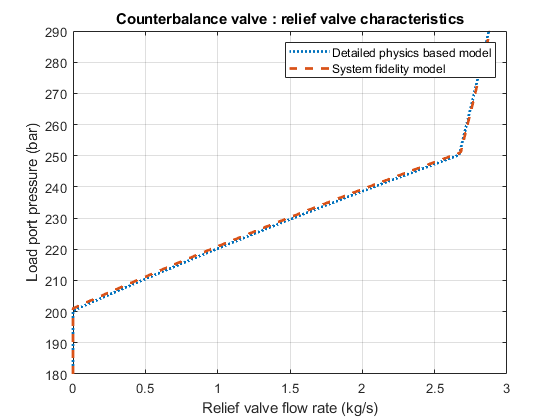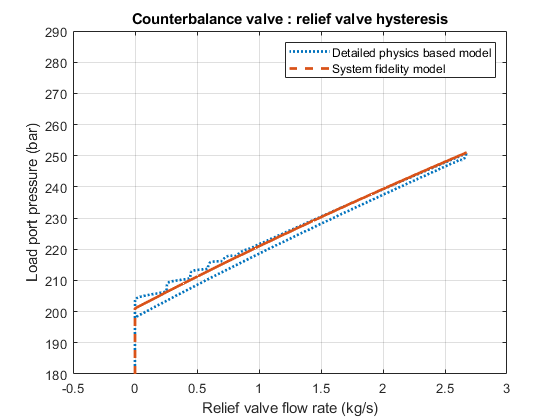Counterbalance Valve with Test Harness
This example shows how to model, parameterize, and test a counterbalance valve in detailed fidelity and system level fidelity using a variant subsystem. Running the model generates a plot of the flow from the load port to the back port due to the relief action of the counterbalance valve using the detailed fidelity variant. A counterbalance valve allows an upstream flow from the back port to the load port through the check valve stage, and it allows a downstream flow from the load port to the back port through the relief stage. Counterbalance valves help with load holding, load actuation speed control, and safety.
Model
The following figure shows the model of a counterbalance valve. Here, connection pLoad is a physical signal port associated with the counterbalance valve load port. Connection pBack is a physical signal port associated with the counterbalance valve back port. This can be the prime mover or the reservoir depending on the mode of operation. Connection pPilot is a physical signal port associated with the external pilot signal. This represents an internal-external pilot and internal drain type counterbalance valve.
The figure shows a cutaway view, where the gray areas belong to the same, solid valve body. The left spring is the check valve stage spring. The right spring is the relief valve stage spring.

Counterbalance Valve Subsystem
This subsystem demonstrates how to use the variant subsystem to model the counterbalance valve using detailed physics and the system level.

Counterbalance Valve subsystem includes the modeling of the Check Valve Function, Relief Function, and Orifice (IL). The Orifice (IL) models the flow area created due to movement of the check valve poppet and the relief stage spool.

The Check Valve Function models the mass dynamics of the check stage poppet (Black colored body). The check stage operation allows the free upstream flow from the pBack port to the pLoad port of the counterbalance valve.
The Relief Function models the mass dynamics of the relief valve stage spool (Gray colored body). The relief valve stage operation helps with the load holding, load actuation speed control, and safety in the machine operations. The relief valve stage operation allows the controlled reverse downstream flow from the pLoad port to the pBack port of the counterbalance valve.
The following equation represents the mass dynamics of the relief stage spool.

where,
 is the displacement of the relief stage spool from the steady state position.
is the displacement of the relief stage spool from the steady state position. is the mass of the relief stage spool
is the mass of the relief stage spool is the spring stiffness of the relief stage's spring
is the spring stiffness of the relief stage's spring is the spring pre-compression of the relief stage's spring
is the spring pre-compression of the relief stage's spring is the friction force
is the friction force is the hardstop force
is the hardstop force is the annular area of the red colored ring
is the annular area of the red colored ring is the pressure that acts on
is the pressure that acts on  area
area is the annular area of the blue colored ring
is the annular area of the blue colored ring is the pressure that acts on
is the pressure that acts on  area
area is the annular area of the green colored ring
is the annular area of the green colored ring is the pressure that acts on
is the pressure that acts on  area
area

The model assumes that the flow forces due to fluid inertia and momentum change at the ports are negligible. To perform hysteresis and stability analysis, you must include these forces. You can model a flow force using a known force equation or data generated from CFD analysis. Note that these analyses are sensitive to the friction model type and parameters.
Counterbalance Valve (IL) subsystem utilizes Simscape Fluids library block to model the valve.

Load Port Setting and Back Port Setting Subsystem
These subsystems set up the boundary condition at the load port and back port. These subsystems use Simulink® variants to set up the test harness for the check stage and relief stage testing.
portSetting=1; sets up the model to test the check valve stage characteristics.
portSetting=2; sets up the model to test the relief valve stage characteristics.
portSetting=3; or portSetting=4; sets up the model to test the relief valve stage hysteresis. The model includes two flow profiles. However, there are numerous valid flow profiles because the operator can not precisely control the flow injected to the load port while testing the valve.

Simulation Results from Simscape Logging
You can use this model to generate and compare the check valve stage characteristics of the counterbalance valve for the variant subsystems using CounterbalanceValveWithTestHarnessCheckCharacteristics script. To test for the check valve characteristics, you can ramp up the pressure at the back port while keeping the pressure constant at the load port.

You can use this model to generate and compare the relief valve stage characteristics of the counterbalance valve for the variant subsystems using CounterbalanceValveWithTestHarnessReliefCharacteristics script. To test for the relief valve characteristics, you can ramp up the pressure at the load port while keeping the pressure constant at the back port.

You can use this model to generate and compare the relief valve stage hysteresis curve of the counterbalance valve for the variant subsystems using CounterbalanceValveWithTestHarnessHysteresis script. To test for the relief valve hysteresis, you can ramp up the flow to completely open the relief stage and then ramp down the flow to shut off the relief stage at the load port while keeping the pressure constant at the back port. To perform hysteresis analysis, use the component fidelity variant of the counterbalance valve.
